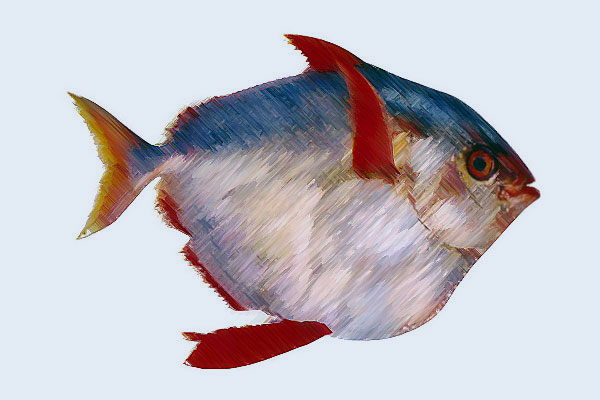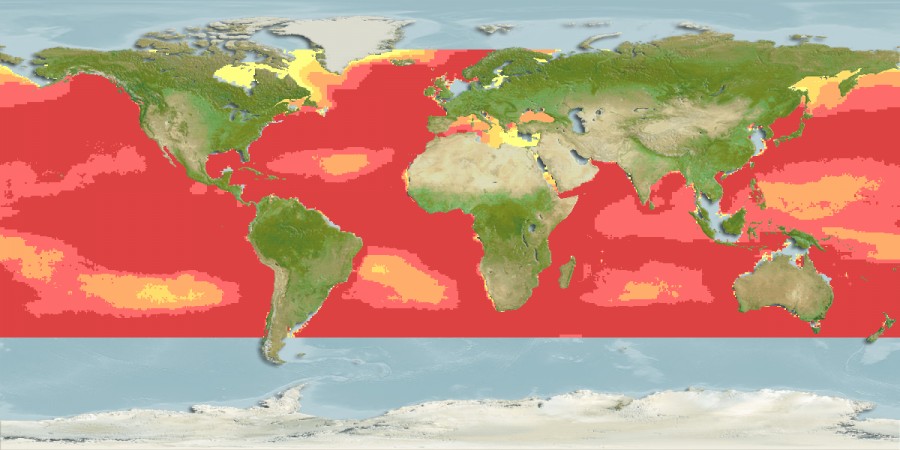Opah
Classification / Names
Actinopterygii (Ray-finned fishes) > Lampriformes (Velifers, tube-eyes and ribbonfishes) > Lampridae(Opah)

Size / Weight / Age
Max length: 200 cm
Common length: 120 cm
Max published weight: 270.0 kg
Environment
Bathypelagic; oceanodromous; marine; depth range 100 – 400 m
Climate / Range
Deep-water; 70°N – 45°S, 180°W – 180°E
Description
Opah (also known colloquially as moonfish, sunfish, kingfish, and Jerusalem haddock) are large, colourful, deep-bodied pelagic Lampriform fish comprising the small family Lampridae (also spelled Lamprididae). There are only two known species in a single genus: Lampris (from the Greek lamprid-, "brilliant" or "clear"). One species is found in tropical to temperate waters of most oceans, while the other is limited to a circumglobal distribution in the Southern Ocean, with the 34th parallel as its northern limit.
Though rarely caught, opah are prized trophies for deep-water anglers as their large size and attractive form lend themselves well to taxidermy. Occasional bycatch from the longline tuna industry is also marketed and prepared as sashimi, as well as being broiled and smoked; opah flesh (despite being stringy and hard to fillet) has a moderate flavour and is well appreciated in this regard, especially in Hawaii. Opah are garnering increasing interest from restaurateurs as other staple species become unavailable. An average of 35 per cent of an opah's weight is utilised for consumption.
Physical Description
Opah are deeply keeled, compressed and discoid fish with conspicuous coloration: the body is a steely blue grading to rosy on the belly, with white spots covering the flanks. Both the median and paired fins are a bright vermillion, contrasting strongly with the body. The large eyes stand out as well, ringed with golden yellow. The body is covered in minute cycloid scales and its silvery, iridescent guanine coating is easily abraded.
Life History
Almost nothing is known of opah biology and ecology. They are presumed to live out their entire lives in the open ocean, at mesopelagic depths of ca. 50–500 metres, with possible forays into the bathypelagic zone. They are apparently solitary but are known to school with tuna and other scombrids. Opah propel themselves via a lift-based labriform mode of swimming; that is, by flapping their pectoral fins. This, together with their forked caudal fins and depressible median fins, indicates that opah—like tuna—maintain themselves at constantly high speeds.
Squid and euphausiids (krill) make up the bulk of the opah diet; small fish are also taken. Pop-up archival transmitting (PAT) tagging operations have indicated that (aside from humans) large pelagic sharks, such as Great White Sharks and Mako Sharks, are primary predators of opah.
Distribution
Worldwide in tropical to temperate waters. Western Atlantic: Grand Banks and Nova Scotia (Canada) to Florida (USA), Gulf of Mexico and the West Indies up to Argentina . Eastern Atlantic: Norway and Greenland to Senegal and south of Angola also Mediterranean. Eastern Pacific: Gulf of Alaska to south of southern California. A single capture in South Georgia marks an incidental occurrence in Southern Ocean.
